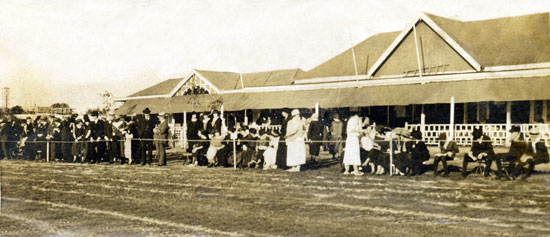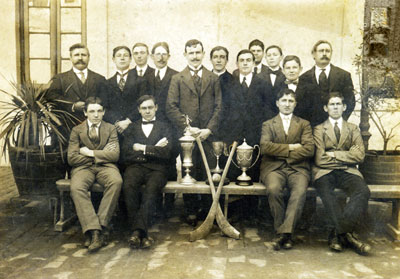|

Athletics meeting at Santo Tomé, 1926
(Hurling Club collection)
|
The
Hurling Club and Identity
The early
group of predominantly male, Catholic and urban
middle-class employees who started the Hurling Club in the
1920s resisted the Anglophile attitudes typical of many
contemporary Irish and Argentine landed families. Though
hurling originally represented a factor of differentiation
from these other groups, it also led to insularity. The
adoption of the more widely played sports of rugby and
hockey enabled club members to assert their identity in
the wider community. Whilst hurling was first viewed as
masculine entertainment, perceptions began to change from
the 1930s onwards, when women were not only accepted as
companions of the male members, but as full members
themselves. The success of female hockey is a
manifestation of this successful integration of women in
the Club.
The Club
still continues to successfully maintain an Irish
identity, though this is being challenged through a
decline in participation from members of the
Irish-Argentine community and a concomitant rise in
members from the wider community. The then Irish Foreign
Minister Dick Spring paid an official visit to the Hurling
Club in 1996 and recalled that ‘it was a memorable
experience to see the green jersey, complete with
shamrock, worn with distinction by the players of the
Hurling Club with such names as Scully (sic),
[14] Rush and McAllister -
in a match against the Rugby Club of Buenos Aires (sic)’
(Spring, 1996). To some extent the impact on the unique
identity of the club through the diminution in
participation from the Irish-Argentines has been offset by
the large number of touring Irish rugby clubs, other
sporting clubs and official delegations from Ireland that
visit the club on a regular basis. In recognition of its
strong Irish-Argentine ethos and its capacity to continue
the Irish-Argentine sense of identity and links with
Ireland, in 2007 the Club was given a grant by the Irish
Department of Foreign Affairs as part of their annual
grants programme to Irish community organisations in the
Southern Hemisphere.
Ronnie
Quinn
Member of the Hurling Club, Buenos Aires
|

St. Patrick hurling team at Mercedes,
1917
(Hurling Club collection)
|
Acknowledgements
I am
extremely grateful to Robbie McCormack for generously
sharing his unpublished work, and to Jimmy O’Durnin of
The Southern Cross for providing useful material from
the newspaper’s archives.
Notes
[1] Hurling is a
game similar to hockey, played with a small ball and a
curved wooden stick called a hurley. You may strike the
ball on the ground, and, unlike hockey, in the air. You
can also put the ball on your hurley and carry it.
[2] The modern
Irish language word for hurling is iománaíocht and
a hurley stick is camán.
[3] Mercedes is
a town in the province of
Buenos Aires. It is located
100 km west from the city of Buenos Aires
and 30 km south west of Luján.
[4] Capitán
Sarmiento is a town located around 160 km north of the
City of Buenos Aires.
[5] Swift was a
company set up in 1907 to export meat products to Europe.
[6] Agar Cross
began importing and selling machinery and farm equipment
in 1875, later branching into windmill sales and the
agrochemical sector.
[7] Duperial is
an Argentine chemical company.
[8] Bearna
Baoghail (‘gap of danger’), refers to the moment in a
siege when the fortification has been breached and the
area is extremely dangerous for defenders. These words
were included by Peadar Kearney in his Soldiers Song
(1907), which in the Irish language is the national anthem
of Ireland: ‘Tonight we'll man the Bearna Baoghail, / In
Erins cause come woe or weal, / ’Mid cannons roar and
rifle's peal, / We'll chant a soldier's song.’
[9] Santiago
Martín Ussher (1867-1960), Roman Catholic priest, was born
in San Andrés de Giles. He received the orders on 22
December 1894. Ussher was parish priest of Baradero and a
member of the ecclesiastical courts of the Buenos Aires
archdiocese.
He published
Los Capellanes Irlandeses en
la Colectividad
Hiberno Argentina
(Buenos Aires, 1954).
[10]
Translated as ‘Holy Places’.
[11]
However, Fraxinus sp., including
American and European ash, is the genus most frequently
cultivated in the streets and parks of Buenos Aires.
[12]
Hurlingham Club was founded in 1888 by influential figures
in the British Community led by John Ravenscroft, as a
sporting and social club.
[13] In
English ‘ovenbirds’.
[14] The surname referred to
should have been Scally rather than Scully.
References
- Cronin,
Mike, ‘An historical identity: Historians and the making
of Irish nationalist identity in the GAA’, Football
Studies, Vol. 1 (August 1998).
- Fanning,
Brendan, ‘Hurling’s “darker side” made it to Argentina’,
The Irish Independent, 3 June 2007.
-
Hurling Club,
website (http://www.hurling-club.com.ar), accessed 7
January 2008.
- King,
Seamus and Darby, Paul, ‘Becoming Irlandes: Hurling and
Irish identity in Argentina’, Sport in Society,
Vol. 10, No 3, May 2007, pp 425-438.
- Mandle,
W.F. ‘Sport as Politics’ in: Cashman and McKernan Sport
in History (Brisbane 1979, University of Queensland
Press).
-
McCormack, Robbie ‘Historia del Hurling Club’
(Buenos Aires: unpublished manuscript, 2007).
- Murray,
Edmundo, Becoming Irlandés: Private Narratives of the
Irish Emigration to
Argentina (1844-1912)
(Buenos Aires: L.O.L.A., 2006).
- Spring,
Dick, ‘Neglected part of the Irish diaspora’, The Irish
Times, 27 April 1996.
- The
Southern Cross, Número Centenario (Buenos
Aires, 1975).
-
Whelan,
Kevin, ‘The Geography of Hurling’ in: History
Ireland,
1:1 (1993), pp. 27-31. |


